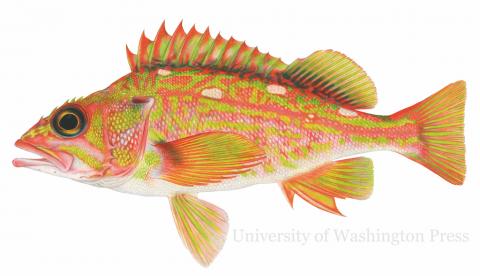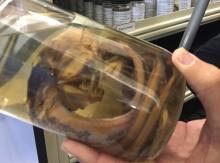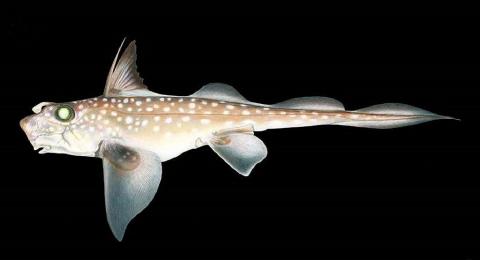Of ratfish, Loch Ness monsters and stuffed sharks: A conversation with the authors of the book 'Fishes of the Salish Sea'
The first comprehensive guide to the fishes of the Salish Sea is the culmination of more than 40 years of research by University of Washington authors Ted Pietsch and Jay Orr. The new three-volume set includes descriptions and illustrations for every fish species known to have been documented within the Salish Sea, all gathered from an exhaustive search of libraries, aquariums, fish collections and even one restaurant.
The Encyclopedia of Puget Sound spoke with Pietsch and Orr and asked them how the book got started and why the Salish Sea should be known for more than just salmon. What lurks in the deepest water? What might be the strangest fish? Or the most fearsome? It was our chance to ask two of the foremost experts.

Pietsch is a curator emeritus at the Burke Museum and a retired professor of biology at the University of Washington School of Aquatic and Fishery Sciences.
Orr is a research biologist at NOAA and serves at the Burke Museum as an affiliate professor and curator. Colorful drawings for each fish described in the book were created by renowned illustrator Joseph Tomelleri.
EoPS: Let's start at the very beginning. How did this book come about?
Ted Pietsch: Well, I’ve been teaching ichthyology here since 1978. I’ve been here for 40 years, and from the very beginning it was a little bit difficult in the laboratory parts of the course to teach students about what’s out there since there was really no book that was adequate to cover all the species. So, I think early on it occurred to me that it would be a good thing to write a book just about our inland waters.
But Jay was the big stimulus. When he came on in 1987 [as a graduate student], we used to sit and talk about how we needed this book. Jay functioned as a teaching assistant in the course and we both realized that this was something that had to be done and we teamed up early on.
Jay Orr: I think the real dramatic point in our decision to go with the book, and how Ted visualized it, was when he said we’re going to do everything in color. This is the first time that’s ever been done. All 260 species are illustrated in color. And even photographs for several species were not available. People only had the line drawings, and in most cases, they were poor line drawings that were just not adequate.
EoPS: Well, you really overcame that. The illustrations are amazing.
Pietsch: Yes, thanks to the artist Joe Tomelleri who is a famous guy among fish people. Every scale is there. Not only are the scales there, but the number of scales is accurate. And there’s a luminosity to his drawings.
Orr: I guess the thing we keep hearing from people is that they didn’t realize how colorful the fishes of the Salish Sea are. They often have this picture of blues and grays. Sort of this northwest cool. But the colors really are spectacular, and I think Joe captured that.
 The Burke Museum is the largest collection of North Pacific fishes in the world and possibly the largest single collection of fish specimens (such as this viperfish above) of any sort. Hear a description of the collection from Ted Pietsch.
The Burke Museum is the largest collection of North Pacific fishes in the world and possibly the largest single collection of fish specimens (such as this viperfish above) of any sort. Hear a description of the collection from Ted Pietsch. EoPS: Now, having worked on this book for more than 30 years — in your case, Ted, for 40 years — was there anything in it that completely surprised you?
Pietsch: Over and over again we were shocked to see that there are more species than we thought. I would say to Jay, “Stop looking and don’t tell me anymore!” Because every time we’d have to find specimens and photos for Joe and create new entries, and eventually we had to publish the book.
Orr: And we’re still revising the list of species. I’m a co-author on a paper coming out soon that changes one of the species’ names. And it was because of the work on the book that we were able to make the correction.
EoPS: So far, you’ve found 260 species of fish known to have occurred in the Salish Sea. Can you tell us about how you got to that number?
Pietsch: It’s important for people to know that what the book contains are all the records of any fish that was ever caught here. And that means that maybe one specimen in all of time has been found. Like, for example, the thresher shark.
Only a single specimen of the thresher shark was recorded and vouchered because there’s a stuffed specimen that was in a restaurant for many years. It’s an interesting story because it disappeared and nobody knows where it is now. It was 12 feet long, I think, if you count from the tip of the snout to the tip of the tail.
This is something that somehow wandered in. Maybe a current pulled it in through the Strait of Juan de Fuca, and it made its way. It was collected, I think, on salmon gear just north of the San Juan Islands back in the 1930s and never collected again.
EoPS: It’s interesting that you are collecting these fish specimens from so many different places, including more traditional collections too.
Pietsch: Yes, we made good use of fish collections around the world. Not only ours [at the Burke Museum], which of course was the most important, but also the California Academy of Sciences, the L.A. County Museum, UBC’s [the University of British Columbia], and also the British Museum of Natural History in London. It’s Important to give a plug for natural history collections. The work that the Burke Museum does to maintain these things is hugely important to our understanding. [You can hear more about the Burke Museum fish collection from Ted Pietsch in a short audio clip available here.]
EoPS: I am guessing each one of the 260 fish in the book has a fascinating story. I can’t resist indulging my curiosity. What’s the strangest fish you’ve come across in the Salish Sea?
Pietsch: I always think of the ratfish as being a really strange animal. I mean, it’s got nostrils like a rabbit. It’s got buck teeth. It’s got giant eyeballs. There's a spine on the top of its back that is toxic that cause a lot of problems if you get stung by it. So that’s a really weird thing. But they are one of the most common fish. They take up more of the biomass than almost any bony fish in the Salish Sea.
EoPS: I talk to biologists and they say they are always pulling up ratfish. All the time.
Pietsch: Right. We don’t quite know why. They belong to a family that is worldwide and in most all other cases are really deep-water fish, but in Puget Sound and in the Salish as a whole they come up into fairly shallow water. Why there is just so much biomass, people don’t know or understand.
Orr: The names associated with ratfish, I think, have always been fascinating. It is called the ratfish as a general common name, but its scientific name is hydrolagus which means “water bunny.”
EoPS: That’s a little nicer.
Orr: Yes. And the family is the Chimaeridae. The Chimaera is a phantasm, a mysterious thing.

EoPS: I can just imagine pulling up one of those fish for the first time and seeing it and wondering. That’s a bizarre looking creature.
Pietsch: Well, being associated with the fish collection over so many decades, we get people phoning in or sending an email: ‘Boy, I’ve been fishing around here for 40 or 50 years and I’ve never seen anything like this.’ And it turns out it’s a rat fish.
EoPS: They might have thought they found Bigfoot.
Pietsch: Yes. There are a lot of stories about people writing in and saying they’ve found something unusual. There was a lady who phoned my office, and she said I’ve found a little Loch Ness monster inside a can of tuna. And I said, ‘Oh, really.’ You know, you try to be nice because you don’t know what this is. And I said, 'Gosh, would you be able to bring it by?' So, she came by and here’s this can of tuna. She lifted up the lid and here’s something that looks kind of like… It’s got legs. It’s got a long back and a tail. It’s got a long kind of neck. And it turned out when I put this under a microscope that it was a branched blood vessel from a fish of some sort — not a tuna because it was so tiny — but you could tell it was a blood vessel. There were hollow tubes. But it was just in the right shape for a Loch Ness monster and so we had a good time over it.
EoPS: OK, another indulgent question: What’s the most fearsome fish in the Salish Sea? I think about the great white shark. Is there anything that compares to that?
Pietsch: Well, we don’t have any of those. But you might consider the salmon shark. That’s pretty fearsome if you came across that and you were underwater. It would be pretty scary.
Orr: Yes. We used to say that it’s like a great white. It’s never been implicated in eating humans, but that’s just because humans don’t swim in the North Pacific very often. It’s too cold. But it is a fearsome thing. It’s feeding on seals and sea lions.
Pietsch: Barracuda are from here. Barracuda are known from our waters. That’s actually a warm water fish that comes in very rarely.
Orr: On a small scale, something that is fearsome to things it can eat is the viper fish. It has huge teeth. Its lower teeth fit up into a space in its head because they are so large. It’s found in deep water.
EoPS: Now that the book is out, is there anything that you feel the general public needs to know about the fishes of the Salish Sea? Is there one takeaway you would like to leave with people?
Pietsch: Well, I think, to understand that the animals are just gorgeous things in their own right. They ‘re not just something to put on the plate to eat. They need to be respected just like you respect a work of art. They are beautiful to our eyes and our brains and people should realize and respect these animals for their own intrinsic beauty and what they do.
Orr: I’ll add that respecting the ecosystem as a whole is important too. You should understand that each of these fishes has a unique role to play within the ecosystem. In basically every type of habitat within the Salish Sea you can find a species of fish that is specializing in that habitat. And to understand, as Ted was saying, how beautiful the fish are. They don’t have to be beautiful to be important, but to understand their natural beauty is really awesome, frankly.
Pietsch: I think Jay and I interpret beauty in a broader sense than most people. A lot of people say ‘This is the ugliest damn looking fish I’ve ever seen.’ And to us, ‘Wow, it’s so gorgeous. Look at all the little bits and pieces that come together to make it a whole.’
Orr: There’s functional beauty, too.
Pietsch: That’s a good way of putting it.
EoPS: The beautiful ratfish, right?
Pietsch: Beautiful animal!
“Fishes of the Salish Sea” is published by University of Washington Press.






